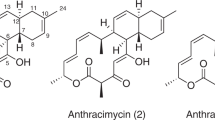Abstract
A new cell cycle inhibitor, nidurufin (1), was isolated from the marine-derived fungus Penicillium flavidorsum SHK1-27. An evaluation of antitumor activity indicated that 1 induced in vitro cell cycle arrest at G2/M transition in the K562 cell line in a concentration and timedependent manner, with an IC50 value of 12.6 M.
Similar content being viewed by others
References
Aucamp, P. J. and Holzapfel, C. W., Polyhydroxyanthraquinones from Aspergillus versicolor, Aspergillus nidulans, and Bipolaris sp. Their significance in relation to biogenetic theories on aflatoxin B1. J. S. Afr. Chem. Inst. J., 23, 40–56 (1970).
Birkinshaw, J. H., Roberts, J. C., and Roffey, P., Studies in mycological chemistry. XIX. Product “B” (averantin) [1,3,6,8-tetrahydroxy-2-(1-hydroxyhexyl)anthraquinone], a pigment from Aspergillus versicolor (Vuillemin) Tirwbosch. J. Chem. Soc. Perkin Trans. I, 9, 855–857 (1966).
Blunt, J. W., Copp, B. R., Munro, M. H., Northcote, P. T., and Prinsep, M. R., Marine natural products. Nat. Prod. Rep., 27,165–237 (2010).
Dhulipala, V. C., Welshons, W. V., and Reddy, C. S., Inhibition of human embryonic patatal mesenchymal cell cycle by secalonic acid D: a probable mechanism of its cleft palate induction. Orthod. Craniofac. Res., 7, 227–236 (2004).
Ebada, S. S., Lin, W., and Proksch, P., Bioactive sesterterpenes and triterpenes from marine sponges: occurrence and pharmacological significance. Mar. Drugs, 8, 313–346 (2010).
Lee, Y. M., Li, H., Hong, J., Cho, H. Y., Bae, K. S., Kim, M. A., Kim, D. K., and Jung, J. H., Bioactive metabolites from the sponge-derived fungus Aspergillus versicolor. Arch. Pharm. Res., 33, 231–235 (2010).
Liu, R., Cui, C. B., Duan, L., Gu, Q. Q., and Zhu, W. M., Potent in vitro anticancer activity of metacycloprodigiosin and undecylprodigiosin from a sponge-derived actinomycete Saccharopolyspora sp. nov. Arch. Pharm. Res., 28, 1341–1344 (2005).
Maskey, R. P., Grün-Wollny, I., and Laatsch, H., Isolation, structure elucidation and biological activity of 8-O-methylaverufin and 1,8-O-dimethylaverantin as new antifungal agents from Penicillium chrysogenum. J. Antibiot., 56, 459–463 (2003).
Mizukami, T., Asai, A., Yamashita, N., Nakano, H., Kakita, S., Kita, K., and Gomi, K., Anticancer agents containing nidurufin derivatives and their preparation. Jpn. Kokai Tokkyo Koho, pp. 8. JP09002951 A2 19970107 (1997).
Murphy, R. A. Jr. and Cava, M. P., Stereochemistry of nidurufin: synthesis of 6,8-dideoxynidurufin and 6,8-dideoxyepinidurufin. J. Am. Chem. Soc., 106, 7630–7632 (1984).
Ren, H., Tian, L., Gu, Q., and Zhu, W., Secalonic acid D; A cytotoxic constituent from marine lichen derived fungus Gliocladium sp. T31. Arch. Pharm. Res., 29, 59–63 (2006).
Ren, H., Gu, Q.-q., and Cui, C.-b., Anthraquinone derivatives produced by marine-derived Penicillium flavidorsum SHK1-27 and their antitumor activities. Chinese Journal of Medicinal Chemistry, 17, 148–156 (2007).
Shier, W. T., Lao, Y., Steele, T. W. J., and Abbas, H. K., Yellow pigments used in rapid identification of aflatoxinproducing Aspergillus strains are anthraquinones associated with the aflatoxin biosynthetic pathway. Bioorg. Chem., 33, 426–438 (2005).
Yabe, K., Chihaya, N., Hamamatsu, S., Sakuno, E., Hamasaki, T., Nakajima, H., and Bennett, J. W., Enzymatic conversion of averufin to hydroxyversicolorone and elucidation of a novel metabolic grid involved in aflatoxin biosynthesis. Appl. Environ. Microbiol., 69, 66–73 (2003).
Author information
Authors and Affiliations
Corresponding author
Rights and permissions
About this article
Cite this article
Ren, H., Liu, Ww. Nidurufin as a new cell cycle inhibitor from marine-derived fungus Penicillium flavidorsum SHK1-27. Arch. Pharm. Res. 34, 901–905 (2011). https://doi.org/10.1007/s12272-011-0606-1
Received:
Revised:
Accepted:
Published:
Issue Date:
DOI: https://doi.org/10.1007/s12272-011-0606-1




